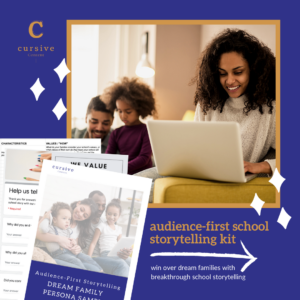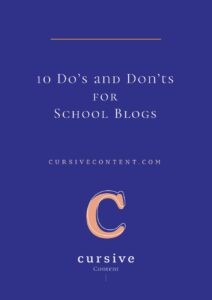10 Do’s and Don’ts for School Blogs

Here’s the frustrating truth about blogging: what works for one school might not work for another.
For a variety of reasons, topics that sizzle on one blog might fizzle on another; the posting schedule for Blog A simply might not be as effective for Blog B.
But while great blogging is an art, there are some guidelines you can follow that will help fast-track your success and allow you to skip over some major mistakes.
New: Audience-First School Storytelling Kit
Want to learn exactly how to win over dream families with breakthrough school storytelling? This on-demand kit includes instant access to:
- In-depth video workshop
- Workshop workbook
- Family survey template
- Email template
- Voice of Customer research spreadsheet
- Audience persona template
- Sample dream family persona
DON’T blog about what interests you.
What is most interesting to you, your board members, faculty and leadership might not be what is most interesting to your audience. Since the content you create doesn’t need to appeal to anyone but your audience, you have to be prepared to ditch your own preferences.
DO get to know your audience.
Who do you want to read your blog? What are their interests? What do they care about? What about your school would be interesting to them?
These are some of the questions you need to be able to answer in order to create blog content that connects with your audience. It’s worth taking the extra time to become an expert in the people you want to read your blog. Only then will you be able to brainstorm the ideas and write the posts that will lead them to become devoted readers.
DON’T rush the process.
The natural reaction to an idea that lights you up is a lets-do-it-now attitude. That enthusiasm is great and can serve you well…as long as it doesn’t cause you to rush the process.
Like most good marketing tactics, creating a good blog takes time. There is a lot to consider, from aesthetic to tone to topics to schedule. It takes dedication to work through the practicalities of your ideas. Don’t let that scare you.
DO take time to create a strategy before you begin.
If I could give just ONE piece of advice to anyone creating a blog, it would be this: develop a strategy first. This step will save you time, money, and frustration because you can take the time to clearly outline your blog’s purpose, and define what makes your blog interesting and different. You’ll take the time to consider your school’s unique perspective, voice, and tone.
Strategy will be your guiding light when you are lost or uncertain. It will propel you forward and keep you on track.
DON’T worry about what other schools are doing.
When I was a kid, my mother always used to say, “If your friends jumped off a bridge, would you do it, too?”
That same type of question applies here (thanks, Mom, for the lasting life lessons). If School A blogs about a topic, does that mean you should? If School B starts posting every day, should you? And the answer is always no. Or at least, not necessarily.
While it is a good thing to know your competition, it is not a good thing to get so wrapped up in what they’re doing that you base your actions on a reaction to their work.
DO create a blog that is true to you.
When you don’t worry about what other people are up to, you are free to be just who you are. And that is what will help you stand out. As the lovely Judy Garland once said:
“Always be a first-rate version of yourself rather than a second-rate version of somebody else.”
A blog that reflects your school is just easier: easier to write, easier to develop topics, easier to maintain. It’s better for your audience, too, since they’ll have the opportunity to get to know your school through your blog.
DON’T expect instant results.
There are very few overnight success stories here (in fact, there might be none at all). Blogging takes time and you need to prove that you’re worthy. You need Google to start ranking your posts, you need to attract and retain your audience, you need to develop a library of content.
If you launch your blog and you barely hear a murmur in response to all your hard work: keep going. Give it six months before you start to judge its effectiveness.
DO craft a plan for sharing and promoting your blog.
Just because instant success isn’t a thing doesn’t mean that you are helpless in making success happen.
Create a plan for sharing your blog on social media, promoting it to your email list, mentioning it on your website, and making faculty and staff members aware of your efforts. All of these efforts will increase its reach and help your blog get traction faster. Remember: people can’t read (and love!) your blog if they don’t know it exists.
DON’T aim for a one-way flow of information.
As content evolves, so do people’s expectations. And today, people generally expect to be able to be involved in the conversation in some way.
You don’t want your blog posts to be a press release or brochure in a different format; a blog provides you with ways to link to other content, encourage comments, generate email signups, and connect to social media.
Don’t think of your blog content as static or set-it-and-forget-it.
DO create ways to get your audience involved.
This is where my content nerd-o-meter jumps off the charts, because schools have so many exciting ways to get their audience involved in content—whether it’s in idea generation, getting involved on social media, or even writing stories.
When your audience can participate, your blog becomes more vibrant and engaging. Think of ways you can encourage that interaction, whether virtually or in real life.
It can often involve more time, strategic thinking, and dedication than you first realized to create and maintain a successful blog. But it can also be a whole lot of fun. DON’T be afraid. DO make this the year of the blog.
Are you ready to create a blog your audience will love? Browse our FREE Resource Library for templates and worksheets that will help you get started!
MORE ARTICLES
-
 Clarity in 50 Words or Less: How to Write Your School’s One-Sentence Story
Clarity in 50 Words or Less: How to Write Your School’s One-Sentence Story -
 The 4 Building Blocks of a Strong School Story (and Why AI Needs Them)
The 4 Building Blocks of a Strong School Story (and Why AI Needs Them) -
 How to Stop ChatGPT from Making Your School Sound Generic
How to Stop ChatGPT from Making Your School Sound Generic -
 What Should Your School Do with Its Blog Now That AI Is Changing Search?
What Should Your School Do with Its Blog Now That AI Is Changing Search? -
 What Is Your Private School’s Bold & Unifying Big Promise?
What Is Your Private School’s Bold & Unifying Big Promise? -
 Viewbook Best Practices for Private Schools
Viewbook Best Practices for Private Schools -
 AI Writing Prompts to Power Private School Storytelling
AI Writing Prompts to Power Private School Storytelling -
 How to Write a Magnetic Private School “About” Page
How to Write a Magnetic Private School “About” Page


